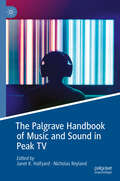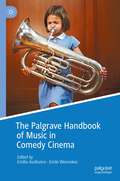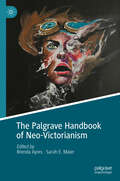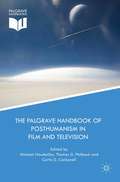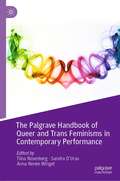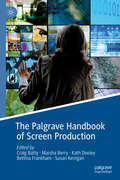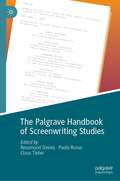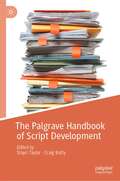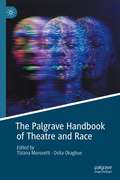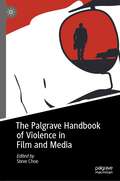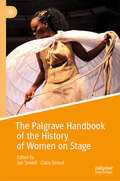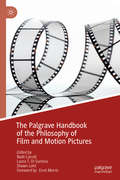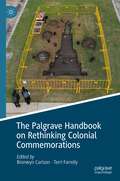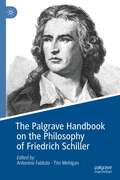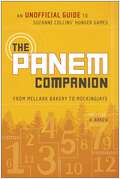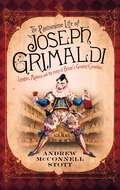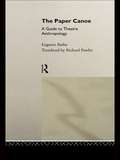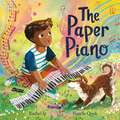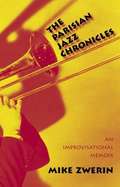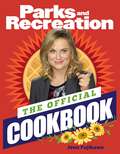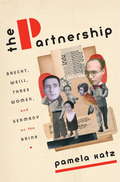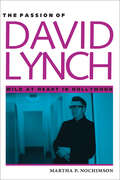- Table View
- List View
The Palgrave Handbook of Music and Sound in Peak TV
by Janet K. Halfyard Nicholas ReylandThe Palgrave Handbook to Music and Sound in Peak TV charts the transformation of television’s sonic storytelling during the new “golden age” of televisual narrative from the late 1990s to the early 2020s. Grounded in close analytical, critical, and theoretical work identifying the key traits of music and sound in this “peak TV” period, the book casts its critical net wider to develop interpretations of significance not just for screen music studies and musicology, but for screen and media studies too. By theorizing “peakness” with respect to sound and music, and by drawing together contributions from a diverse collection of prominent musicologists, media scholars, and practitioners, this handbook provides the authoritative guide to the role music has played in creating the success of some of the most culturally and commercially significant popular art of the early twenty-first century. The volume contains 25 essays in three main sections—Concepts and Aesthetics, Practices and Production, and Audiences and Interpretations. Topics discussed include peakness, complexity, ostentatious scoring, antiheroes, memory, franchises, worldbuilding, nostalgia, maternity, trauma, actor’s voices, title sequences, library music, branding, queer/camp scoring, kids TV, captioning, industry practices, HBO, and sound design. Shows examined include The Sopranos, The Wire, Game of Thrones, Battlestar Galactica, Westworld, Buffy the Vampire Slayer, Stranger Things, The Bridge, Dexter, Killing Eve, Mad Men, American Horror Story, Rings of Power, Fargo, Peaky Blinders, Call the Midwife, Twin Peaks, and Twin Peaks: The Return.
The Palgrave Handbook of Music in Comedy Cinema
by Emilio Audissino Emile WennekesThis handbook tackles the understudied relationship between music and comedy cinema by analysing the nature, perception, and function of music from fresh perspectives. Its approach is not only multidisciplinary, but also interdisciplinary in its close examination of how music and other cinematic devices interact in the creation of comedy. The volume addresses gender representation, national identities, stylistic strategies, and employs inputs from cultural studies, musicology, music theory, psychology, cognitivism, semiotics, formal and stylistic film analysis, and psychoanalysis. It is organised in four sections: general introductions, theoretical investigations, music and comedy within national cinemas, and exemplary case studies of films or authors.
The Palgrave Handbook of Neo-Victorianism
by Brenda Ayres Sarah E. MaierThis handbook offers analysis of diverse genres and media of neo-Victorianism, including film and television adaptations of Victorian texts, authors’ life stories, graphic novels, and contemporary fiction set in the nineteenth century. Contextualized by Sarah E Maier and Brenda Ayres in a comprehensive introduction, the collection describes current trends in neo-Victorian scholarship of novels, film, theatre, crime, empire/postcolonialism, Gothic, materiality, religion and science, amongst others. A variety of scholars from around the world contribute to this volume by applying an assortment of theoretical approaches and interdisciplinary focus in their critique of a wide range of narratives—from early neo-Victorian texts such as A. S. Byatt’s Possession (1963) and Jean Rhys’ Wide Sargasso Sea (1966) to recent steampunk, from musical theatre to slumming, and from The Alienist to queerness—in their investigation of how this fiction reconstructs the past, informed by and reinforming the present.
The Palgrave Handbook of Posthumanism in Film and Television
by Michael Hauskeller Thomas D. Philbeck Curtis D. CarbonellWhat does popular culture's relationship with cyborgs, robots, vampires and zombies tell us about being human? Insightful scholarly perspectives shine a light on how film and television evince and portray the philosophical roots, the social ramifications and the future visions of a posthumanist world.
The Palgrave Handbook of Queer and Trans Feminisms in Contemporary Performance
by Tiina Rosenberg Sandra D’Urso Anna Renée WingetThe purpose of this Handbook is to provide students with an overview of key developments in queer and trans feminist theories and their significance to the field of contemporary performance studies. It presents new insights highlighting the ways in which rigid or punishing notions of gender, sexuality and race continue to flourish in systems of knowledge, faith and power which are relevant to a new generation of queer and trans feminist performers today.The guiding question for the Handbook is: How do queer and trans feminist theories enhance our understanding of developments in feminist performance today, and will this discussion give rise to new ways of theorizing contemporary performance? As such, the volume will survey a new generation of performers and theorists, as well as senior scholars, who engage and redefine the limits of performance. The chapters will demonstrate how intersectional, queer and trans feminist theoretical tools support new analyses of performance with a global focus. The primary audience will be students of theatre/ performance studies as well as queer /gender studies. The volume’s contents suggest close links between the formation of queer feminist identities alongside recent key political developments with transnational resonances. Furthermore, the emergence of new queer and trans feminist epistemologies prompts a reorientation regarding performance and identities in a 21st-century context.
The Palgrave Handbook of Screen Production
by Craig Batty Marsha Berry Susan Kerrigan Kath Dooley Bettina FrankhamThis handbook is an essential creative, critical and practical guide for students and educators of screen production internationally. It covers all aspects of screen production—from conceptualizing ideas and developing them, to realizing and then distributing them—across all forms and formats, including fiction and non-fiction for cinema, television, gallery spaces and the web. With chapters by practitioners, scholars and educators from around the world, the book provides a comprehensive collection of approaches for those studying and teaching the development and production of screen content. With college and university students in mind, the volume purposely combines theory and practice to offer a critically informed and intellectually rich guide to screen production, shaped by the needs of those working in education environments where ‘doing’ and ‘thinking’ must co-exist. The Palgrave Handbook of Screen Production fills an important gap in creative-critical knowledge of screen production, while also providing practical tools and approaches for future practitioners.
The Palgrave Handbook of Screenwriting Studies
by Rosamund Davies Claus Tieber Paolo RussoThis book provides an overview of the growing field of screenwriting research and is essential reading for both those new to the field and established screenwriting scholars. It covers topics and concepts central to the study of screenwriting and the screenplay in relation to film, television, web series, animation, games and other interactive media, and includes a range of approaches, from theoretical perspectives to in-depth case studies. 44 scholars from around the globe demonstrate the range and depths of this new and expanding area of study. As the chapters of this Handbook demonstrate, shifting the focus from the finished film to the process of screenwriting and the text of the screenplay facilitates valuable new insights. This Handbook is the first of its kind, an indispensable compendium for both academics and practitioners.
The Palgrave Handbook of Script Development
by Craig Batty Stayci TaylorThe Palgrave Handbook of Script Development provides the first comprehensive overview of international script development practices. Across 40 unique chapters, readers are guided through the key challenges, roles and cultures of script development, from the perspectives of creators of original works, those in consultative roles and those giving broader contextual case studies. The authors take us inside the writers’ room, alongside the script editor, between development conversations, and outside the mainstream and into the experimental. With authors spanning upwards of 15 countries, and occupying an array of roles – including writer, script editor, producer, script consultant, executive, teacher and scholar, this is a truly international perspective on how script development functions (or otherwise) across media and platforms. Comprising four parts, the handbook guides readers behind the scenes of script development, exploring unique contexts, alternative approaches, specific production cultures and global contexts, drawing on interviews, archives, policy, case study research and the insider track. With its broad approach to a specialised practice, the Palgrave Handbook of Script Development is for anyone who practices, teaches or studies screenwriting and screen production.
The Palgrave Handbook of Theatre and Race
by Tiziana Morosetti Osita OkagbueThe first comprehensive publication on the subject, this book investigates interactions between racial thinking and the stage in the modern and contemporary world, with 25 essays on case studies that will shed light on areas previously neglected by criticism while providing fresh perspectives on already-investigated contexts. Examining performances from Europe, the Americas, the Middle East, Africa, China, Australia, New Zealand, and the South Pacifi c islands, this collection ultimately frames the history of racial narratives on stage in a global context, resetting understandings of race in public discourse.
The Palgrave Handbook of Violence in Film and Media
by Steve ChoeThe chapters contained in this handbook address key issues concerning the aesthetics, ethics, and politics of violence in film and media. In addition to providing analyses of representations of violence, they also critically discuss the phenomenology of the spectator, images of atrocity in international cinema, affect and documentary, violent video games, digital infrastructures, cruelty in art cinema, and media and state violence, among many other relevant topics. The Palgrave Handbook of Violence in Film and Media updates existing studies dealing with media and violence while vastly expanding the scope of the field. Representations of violence in film and media are ubiquitous but remain relatively understudied. Too often they are relegated to questions of morality, taste, or aesthetics while judgments about violence can themselves be subjected to moral judgment. Some may question whether objectionable images are worthy of serious scholarly attention at all. While investigating key examples, the chapters in this handbook consider both popular and academic discourses to understand how representations of violence are interpreted and discussed. They propose new approaches and raise novel questions for how we might critically think about this urgent issue within contemporary culture.
The Palgrave Handbook of the History of Women on Stage
by Jan Sewell Clare SmoutThis book brings together nearly 40 academics and theatre practitioners to chronicle and celebrate the courage, determination and achievements of women on stage across the ages and around the globe. The collection stretches from ancient Greece to present-day Australasia via the United States, Soviet Russia, Europe, India, South Africa and Japan, offering a series of analytical snapshots of women performers, their work and the conditions in which they produced it. Individual chapters provide in-depth consideration of specific moments in time and geography while the volume as a whole and its juxtapositions stimulate consideration of the bigger picture, underlining the challenges women have faced across cultures in establishing themselves as performers and the range of ways in which they gained access to the stage. Organised chronologically, the volume looks not just to the past but the future: it challenges the very notions of ‘history’, ‘stage’ and even the definition of ‘women’ itself.
The Palgrave Handbook of the Philosophy of Film and Motion Pictures
by Noël Carroll Laura T. Di Summa Shawn LohtThis handbook brings together essays in the philosophy of film and motion pictures from authorities across the spectrum. It boasts contributions from philosophers and film theorists alike, with many essays employing pluralist approaches to this interdisciplinary subject. Core areas treated include film ontology, film structure, psychology, authorship, narrative, and viewer emotion. Emerging areas of interest, including virtual reality, video games, and nonfictional and autobiographical film also have dedicated chapters. Other areas of focus include the film medium’s intersection with contemporary social issues, film’s kinship to other art forms, and the influence of historically seminal schools of thought in the philosophy of film. Of emphasis in many of the essays is the relationship and overlap of analytic and continental perspectives in this subject.
The Palgrave Handbook on Rethinking Colonial Commemorations
by Bronwyn Carlson Terri FarrellyThe Palgrave Handbook on Rethinking Colonial Commemorations explores global efforts, particularly from Indigenous and Bla(c)k communities, to dismantle colonial commemorations, monuments, and memorials. Across the world, many Indigenous and Bla(c)k communities have taken action to remove, rectify and/or re-imagine colonial commemorations. These efforts have had the support of some non-Indigenous and white community members, but very often they have faced fierce opposition. In spite of this, many have succeeded, and this work aims to acknowledge and honour these efforts. As a current and much-debated issue, this book will present fresh findings and analyses of recent and historical events, including #RhodesMustFall, Anzac Day protests, and the transferral of confederate monuments to museums. Comprising of chapters written by Indigenous, Bla(c)k and non-Indigenous authors, from a wide variety of locations, backgrounds and purposes, this topical volume is a timely and important contribution to the fields of memory studies, Indigenous Studies, and cultural heritage.
The Palgrave Handbook on the Philosophy of Friedrich Schiller
by Antonino Falduto Tim MehiganFriedrich Schiller is justly celebrated for his dramas and poetry. Yet, above all, he was a polymath, whose writings enriched a range of fields including history and philosophy. Until now, no comprehensive accounting of this philosophy has been undertaken. The Palgrave Handbook on the Philosophy of Friedrich Schiller makes good this desideratum, treating Schiller's poetry, prose, and dramatic work alongside his philosophical writings and reviewing his thought not only in connection with those who influenced him, such as Kant, Reinhold, and Fichte, but also those he anticipated, such as Hegel, Marx, and the Neo-Kantians. Topics treated in this volume include Schiller's philosophical background, his theoretical writings, Schiller's philosophical writing in light of his entire oeuvre, and Schiller's philosophical legacy. The Handbook also includes an overview of the main topics Schiller addressed in his philosophical writings including philosophical anthropology, aesthetics, moral philosophy, politics and political theory, the philosophy of history, and the philosophy of education. Bringing together the latest research on Schiller and his thought by leading scholars in the field, the Handbook draws attention to Schiller's undiminished importance for philosophical debates today.
The Panem Companion: An Unofficial Guide to Suzanne Collins' Hunger Games, From Mellark Bakery to Mockingjays
by V. ArrowGo deeper into the home of the Hunger Games with the creator of the best-known fan map of Panem What does Panem look like? How does Panem define race? How do Panem's districts reflect the major themes of the trilogy? What allusions to our world are found in Panem names like Finnick, Johanna, Beetee, Cinna, Everdeen, and Mellark? The Panem Companion gives fresh insight into Suzanne Collins' trilogy by looking at the world of the Hunger Games and the forces that kept its citizens divided since the First Rebellion. With a blend of academic insight and true fan passion, V. Arrow explores how Panem could have evolved from the America we know today and uses textual clues to piece together Panem's beliefs about class, ethnicity, culture, gender, sexuality, and more. Includes an extensive name lexicon and color-illustrated unofficial map
The Pantomime Life of Joseph Grimaldi: Laughter, Madness and the Story of Britain's Greatest Comedian
by Andrew McConnell StottThis biography offers a &“vivid portrayal&” of the eighteenth-century English entertainer who &“invented the figure of the classic clown that we know today&” (The Guardian). The son of a deranged Italian immigrant, Joseph Grimaldi (1778–1837) was the most celebrated of English clowns. The first to use white-face makeup and wear outrageous colored clothes, he completely transformed the role of the Clown in the pantomime with a look as iconic as Chaplin&’s Tramp. One of the first celebrity comedians, his friends included Lord Byron and the actor Edmund Kean—and his memoirs were edited by a young Charles Dickens. But underneath the stage paint, Grimaldi struggled with depression, and his life was blighted with tragedy. His first wife died in childbirth, and his son would go on to drink himself to death. The outward joy and tomfoolery of his performances masked a dark and depressing personal life, and instituted the modern figure of the glum, brooding comedian. In this &“exuberant, impassioned portrait,&” biographer Andrew McConnell Stott presents a man who left an indelible mark on the English theatre and the performing arts, but whose legacy is one of human struggle, battling demons and giving it his all in the face of adversity (The Guardian).
The Paper Canoe: A Guide to Theatre Anthropology
by Eugenio BarbaFirst published in 1994. Routledge is an imprint of Taylor & Francis, an informa company.
The Paper Piano: An inspirational picture book for music lovers
by Rachel IpWhen Noah hears beautiful piano music sweeping through the station, he longs to play. Without a pianoof his own, he carefully crafts one out of paper, and the notes fill his head night and day. Until finally, with the help of a neighbour, his musical dream comes true . . .An inspirational picture book about the power of perseverance and music, celebrating the joy that railway station pianos can bring to all. Written by award-winning author Rachel Ip, with artwork from award-winning illustrator Natelle Quek.
The Parasite
by Ramsey CampbellTwenty years after a game of Ouija ends in a ten-year-old's disappearance, Rose Tierney discovers that she has developed psychic powers that enable her to see into the future and travel without her body, but that make her vulnerable to an evil force.
The Parisian Avant-Garde in the Age of Cinema, 1900-1923
by Jennifer WildThe first decades of the twentieth century were pivotal for the historical and formal relationships between early cinema and Cubism, mechanomorphism, abstraction, and Dada. To examine these relationships, Jennifer Wild’s interdisciplinary study grapples with the cinema’s expanded identity as a modernist form defined by the concept of horizontality. Found in early methods of projection, film exhibition, and in the film industry’s penetration into cultural life by way of film stardom, advertising, and distribution, cinematic horizontality provides a new axis of inquiry for studying early twentieth-century modernism. Shifting attention from the film to the horizon of possibility around, behind, and beyond the screen, Wild shows how canonical works of modern art may be understood as responding to the changing characteristics of daily life after the cinema. Drawing from a vast popular cultural, cinematic, and art-historical archive, Wild challenges how we have told the story of modern artists’ earliest encounter with cinema and urges us to reconsider how early projection, film stardom, and film distribution transformed their understanding of modern life, representation, and the act of beholding. By highlighting the cultural, ideological, and artistic forms of interpellation and resistance that shape the phenomenology of a wartime era, The Parisian Avant-Garde in the Age of Cinema, 1900–1923 provides an interdisciplinary history of radical form. This book also offers a new historiography that redefines how we understand early cinema and avant-garde art before artists turned to making films themselves.
The Parisian Jazz Chronicles: An Improvisational Memoir
by Mike ZwerinThis book is built around a structure that treats such subjects of my music column in the International Herald Tribune as Dexter Gordon, Freddy Heineken, Miles Davis, Bob Dylan, Chet Baker, and Melvin Van Peebles as though they were the written notes in big band arrangements.
The Parks and Recreation: Official Cookbook
by Jenn FujikawaPrepare to treat yo self! Parks and Recreation: The Official Cookbook is the ultimate way for fans to visit the kitchens, restaurants, and Harvest Festivals of Pawnee, IN, without ever leaving their homes. And though &“there has never been a sadness that can&’t be cured by breakfast food,&” home cooks of every skill level will be able to recreate meals for any time of day, including: Leslie Knope&’s Favorite JJ&’s Diner Waffles Eagleton Crepes Ron Swanson&’s Meat Tornado Burrito Paunch Burger&’s Double Bason Grenade Deluxe Chris Traeger&’s Turkey Burger and Literally the Best Salad You&’ve Ever Had Stu&’s Stew April and Andy&’s Most Amazing Grilled Cheese Sandwich Ever Made Ben&’s Calzones And don&’t forget to treat yo self to: Donna&’s Mimosas Marshmallow Ron Swansons Sweetums Sugar Splash Floats Featuring more photos, quotes, and many vegetarian, vegan, and gluten-free options than there are rules to The Cones of Dunshire, Parks and Recreation: The Official Cookbook serves up something for every fan!
The Partnership
by Pamela KatzAmong the most creative and outsized personalities of the Weimar Republic, that sizzling yet decadent epoch between the Great War and the Nazis' rise to power, were the renegade poet Bertolt Brecht and the rebellious avant-garde composer Kurt Weill. These two young geniuses and the three women vital to their work--actresses Lotte Lenya and Helene Weigel and writer Elizabeth Hauptmann--joined talents to create the theatrical and musical masterworks The Threepenny Opera and The Rise and Fall of the City of Mahagonny, only to split in rancor as their culture cracked open and their aesthetic and temperamental differences became irreconcilable. The Partnership is the first book to tell the full story of Brecht and Weill's impulsive, combustible partnership, the compelling psychological drama of one of the most important creative collaborations of the past century. It is also the first book to give full credit where it is richly due to the three women whose creative gifts contributed enormously to their masterworks. And it tells the thrilling and iconic story of artistic daring entwined with sexual freedom during the Weimar Republic's most fevered years, a time when art and politics and society were inextricably mixed.
The Partridge Family (The Partridge Family #1)
by Michael AvalloneCan America's top rock group prevail against the evil machinations of a fat but deadly enemy agent- without blowing their cool? If any group can do it, the Partridge family can! They're a high-voltage six-pack of talent and energy--five groovy kids plus one beautiful, mini-skirted Mom--and they've settled down in the Top Ten for., a long, long stay. Even the coolest clan in rock gets put up-tight when a sinister spymaster hunts them down. He's after an international secret they don't even know they're carrying, and he'll stop at nothing. But little does he know what lies ahead when he tangles with that all-American super-singing weapon, THE PARTRIDGE FAMILY
The Passion of David Lynch: Wild at Heart in Hollywood
by Martha P. Nochimson&“This is the best book on David Lynch that has yet been published. Nochimson&’s book is essential reading for anyone interested in contemporary cinema.&” —Brian Henderson, former chair of the Department of Media Study, State University of New York at Buffalo Filmmaker David Lynch asserts that when he is directing, ninety percent of the time he doesn&’t know what he is doing. To understand Lynch&’s films, Martha Nochimson believes, requires a similar method of being open to the subconscious, of resisting the logical reductiveness of language. In this innovative book, she draws on these strategies to offer close readings of Lynch&’s films, informed by unprecedented, in-depth interviews with Lynch himself. Nochimson begins with a look at Lynch&’s visual influences—Jackson Pollock, Francis Bacon, and Edward Hopper—and his links to Alfred Hitchcock and Orson Welles, then moves into the heart of her study, in-depth analyses of Lynch&’s films and television productions. These include Twin Peaks: Fire Walk with Me, Wild at Heart, Twin Peaks, Blue Velvet, Dune, The Elephant Man, Eraserhead, The Grandmother, The Alphabet, and Lynch&’s most recent, Lost Highway. Nochimson&’s interpretations explode previous misconceptions of Lynch as a deviant filmmaker and misogynist. Instead, she shows how he subverts traditional Hollywood gender roles to offer an optimistic view that love and human connection are really possible. &“Nochimson deftly deploys a mixture of feminist criticism, the Bakhtinian notion of the carnivalesque, and an intriguing blend of Jungian and Freudian concepts to make one of our most complex filmmakers seem quite accessible after all.&” —J. P. Telotte, Film Quarterly
